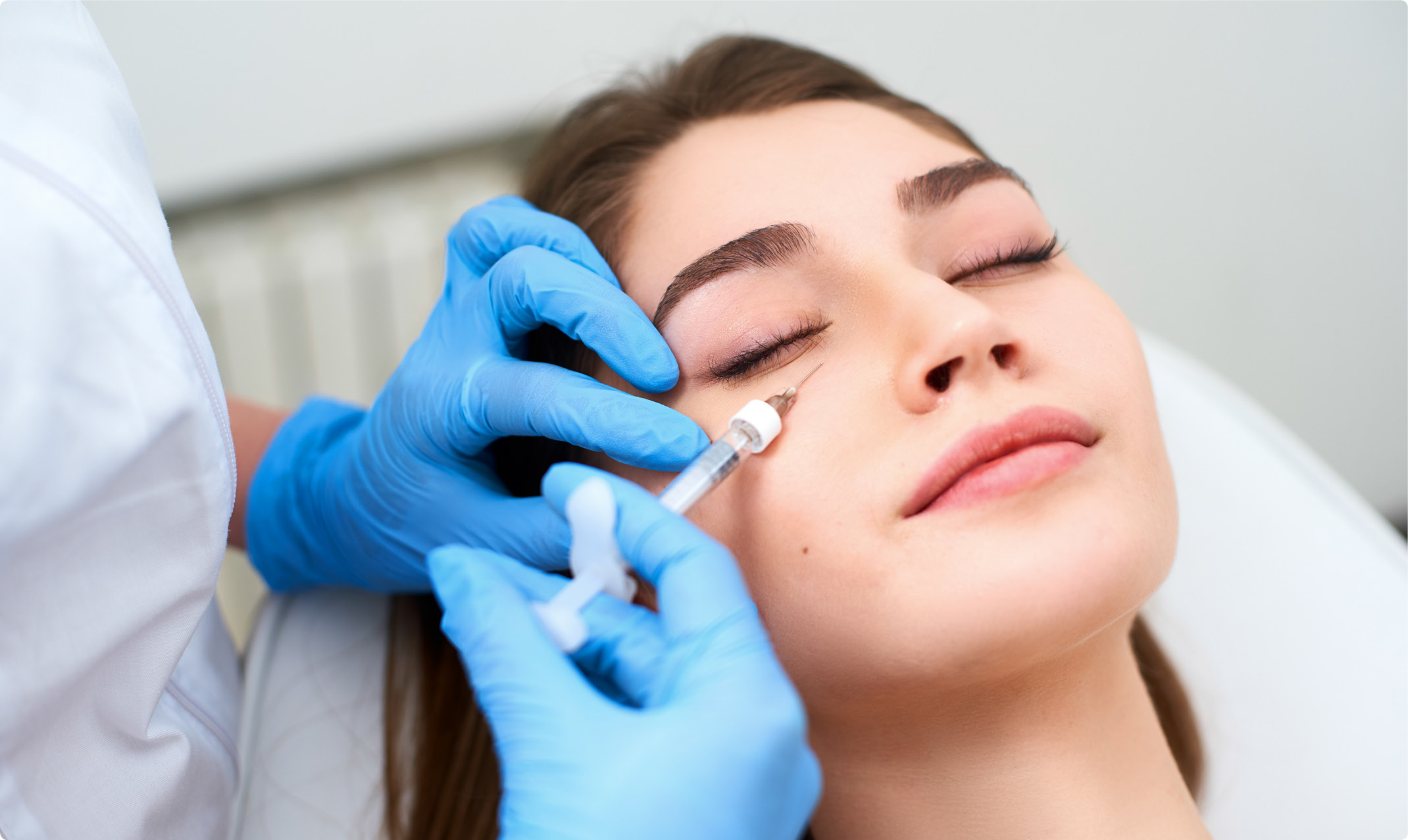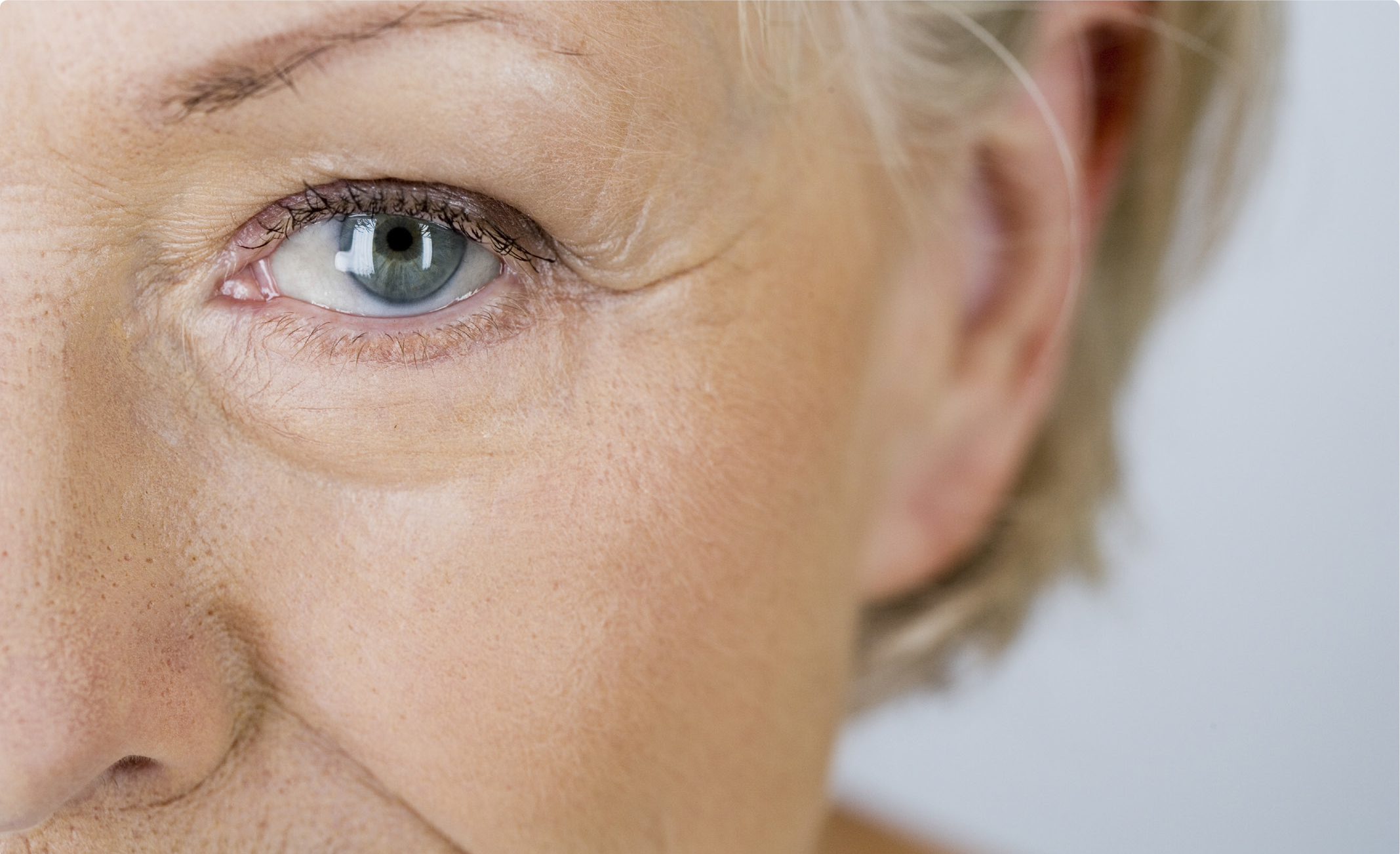
While aesthetic treatments focusing on the lower periorbital area have always been popular, hyaluronic acid has become particularly favoured for the advantages of being stable and biocompatible, as well as keeping water molecules in the skin. Results are also long-lasting (but still temporary and usually reversible) and provide a more natural look (Papakonstantinou et al, 2012). However, treating the tear trough is specialised work, with a host of considerations to take into account.
Signs of ageing
Notoriously, the lower periorbital area shows signs of ageing before other sections of the face because of the combination of natural bone reabsorption around the lower orbit and the depletion of soft tissue due to loss of collagen (Bravo et al, 2015; Vrcek et al, 2016). Vrcek et al (2016) point out that the quality of the skin in this area and a loss of collagen can contribute to the appearance of dark circles, meaning that the effect of ageing in the periorbital area is particularly exaggerated because of this loss.
As skin loses collagen, it begins to sag (Ganceviciene et al, 2012). Alongside the natural ageing process, sun exposure and genetics also play a role in the thinning of skin (Khan and Shaw, 2010), which contributes to the deterioration of the lower periorbital area.
A cosmetic concern
‘The eyes are the windows to the soul’ strikes a chord because it is true. A bright and fresh eye region lends an aura of youth and vitality (Bravo et al, 2015), while gaze direction in conversation can aid interaction and intimacy (Hietanen, 2018). According to Bravo et al (2015), the ageing process in the upper periorbital area can result in ptosis of the upper eyelid, with the possibility of affecting the patient's vision—as well as looking displeasing to the patient. In terms of the lower periorbital area, skin laxity or thinness can lead to an appearance of puffiness or dark circles under the eyes that give a tired, sad or aged look (Vrcek et al, 2016). In severe cases, hyperpigmentation of the area can even influence the patient's sense of self, wellbeing and quality of life (Sarkar et al, 2016).
Products to use
Skin ageing and the associated signs around the lower periorbital area are associated with a lack of moisture (Papakonstantinou et al, 2012). According to Papakonstantinou et al (2012), hyaluronic acid is a key molecule for binding and keeping water molecules in the skin, while Bravo et al (2015) favour it over other non-surgical interventions as it is a stable, biocompatible treatment that provides excellent cosmetic results.
Walker et al (2019) acknowledge the wide variety of hyaluronic acid available to an aesthetic practitioner that differ in concentration, duration, particle-size, cross-linking density and inclusion of lidocaine. For use on the tear trough, monophasic hyaluronic acid is a superior product, as the uniform microspheres ensure the filler migrates less than the biphasic version (Flynn et al, 2011; Mansouri and Goldenburg, 2015).
The importance of aseptic technique
According to Sadashivaiah and Mysore (2010), biofilms are recognised as a cause of dermal filler complications, with the potential for sepsis (Collier, 2014). To reduce the risk of complications, practitioners should follow best practice guidelines from the Cosmetic Practice Standards Authority (2019) to ensure the use of barriers, such as gloves, and that the skin is adequately prepared before injection. Heydenrych et al (2018) make the case that procedural planning and stringent aseptic technique are essential.

The patient's skin should be free of make-up and not only clean, but degreased and disinfected (Heydenrych et al, 2018). The reason the procedure is not classed as sterile is simply because the syringe is not completely sterile, so frequent change of needle is recommended when dealing with several entry points (Heydenrych et al, 2018). When it comes to aseptic technique in relation to treating the lower periorbital area, practitioners can never be too careful. Urdiales-Gálvez et al (2018) recommend setting up emergency procedures and keeping agents such as epinephrine in the treatment room to minimise serious side effects or adverse outcomes.
Injection technique: on the bone versus dermis
When treating the lower periorbital area with hyaluronic acid, several authors report that administering the injection deep into the dermis creates the best effect (Bravo et al, 2015; Hwang, 2016). Hwang (2016) recommends that an injection site below the orbicularis or in the pre-periosteal plane aids coverage. Bravo et al (2015) are more specific, recommending an injection site 2 cm below ‘the lower edge of the orbit in intersection with the lateral line of limbo.’
In Sharad's (2012) review of treatment techniques, he notes that the technique Kenneth and Samantha Steinsapir prefer (Steinsapir and Steinsapir, 2016) sometimes involved digitally elevating the inferior orbital fat in the lower eyelid to expose the preferred injection site. The need to do this is heavily dependent on the current condition of the patient's lower periorbital area.
Cannula versus needle
The choice between cannulas and needles is dependent on the needs of the patient and the current condition of the lower periorbital area. However, blunt-tip cannulas cause less discolouration and bruising (Fulton et al, 2012).
Hwang (2016) suggests several techniques to keep in mind to limit the risks of ischaemic complications through injecting into arterial areas—using a cannula is one such method. Indeed, the cannula is highly rated in the literature, with the understanding that the depth of each insertion should not exceed the orbital width (Tansatit et al, 2015). Blunt-tipped cannulas are also less painful for the patient and they produce less oedema (Sharad, 2012; Fulton et al, 2012). Use of a microcannula also allows for a single entry point, versus many injection sites with a standard needle (Montes et al, 2016).
» Apart from blood supply-related side effects, the Tyndall effect (where the skin takes on a bluish tinge) is very common and predominantly affects patients with a fairer skin tone, but is seen in over 30% of repeat patients «
Lee and Yen (2017) recommend the use of a 30-gauge needle when treating the lower periorbital area. When using a cannula, some literature advises using the same gauge as the cannula to make the initial entrypoint (Bravo et al, 2015)
Short- and long-term effects
Bravo et al (2015) list the common side effects of hyaluronic acid administered to the tear trough as bruising, swelling, discolouration and contour irregularities. The patient needs to be cautioned before treatment that some bruising and swelling is to be expected for a few days afterwards. Mustak et al (2018) note that over 30% of returning patients report contour irregularities, in which case, a follow-up appointment is needed to dissolve some of the hyaluronic acid gel. In the case of a broken blood vessel, local compression needs to be administered immediately, but the condition self-limits between 5 and 10 days (Bravo et al, 2015).
If the procedure causes blocked blood flow, the patient may experience severe pain during the procedure and they can turn pale (Bravo et al, 2015). The injection should be stopped immediately and an attempt to remove the product from the area should be made.
Apart from blood supply-related side effects, the Tyndall effect (where the skin takes on a bluish tinge) is very common and predominantly affects patients with a fairer skin tone, but is seen in over 30% of repeat patients (Hwang, 2016; Mustak et al, 2018). Bravo et al (2015) explain that the effect is caused by the treatment having been administered too superficially.
Complications of the treatment
Although uncommon, there are a few serious complications to the treatment that are worth bearing in mind when initially in consultation with the patient, setting up your treatment room and carrying out aseptic technique.
Symptoms of inflammation indicate infection at the site, but an allergic reaction to hyaluronic acid is also possible—although rare (Hwang, 2016). Antibiotics must be prescribed and the infection neutralised before any treatments of hyaluronidase can be administered, as it can often help spread the infection (Hwang, 2016). In the event of infection via biofilm, it can be more difficult to treat due to the biofilm deployment of a protective matrix, and a two-drug therapy is often recommended (Bravo et al, 2015).
Rarer still are the complications of vision loss. This is caused by the filler entering an artery and migrating through to the central retinal artery due to the higher pressure (Bravo et al, 2015; Hwang, 2016). The risk is lowered through the use of cannulas and the practitioner taking their time when administrating the hyaluronic acid (Bravo et al, 2015). Vision loss is immediate and often accompanied by pain (Hwang, 2016). The patient should visit an eye specialist (preferably a retinal specialist) within an hour and a half from the injection time (Hwang, 2016). Hwang (2016) speculates that the lower rates of vascular complication in the periorbital area are due to the tear trough only being treated by practitioners comfortable with the region and with detailed knowledge of its anatomy.
Inappropriate candidates for lower periorbital area fillers
Patients who retain fluid around their eyes may not be suitable candidates for hyaluronic acid treatment in the tear trough (Hwang, 2016). Heydenrych et al (2018) advise avoiding treating patients with rosacea and acne, as the conditions can contribute to inflammation and biofilm, respectively. Skin conditions need to be managed before the procedure can take place.
If the candidate has one or more active inflammatory diseases, such as Hashimoto's thyroiditis, lupus or rheumatoid arthritis, then hyaluronic acid dermal fillers are not suitable (Heydenrych et al, 2018). If the patient has a history of severe allergy and anaphylactic shock, then, again, the procedure is unsuitable (Heydenrych et al, 2018).

Past rhinoplasty operations can result in hyperpigmentation in the periorbital area (Nemati et al, 2012), but the location of scar tissue created by the procedure may mean the candidate is not suitable for periorbital filler due to risk of intravascular placement (Heydenrych et al, 2018). Heydenrych et al (2018) note that long-term sinus issues can contribute to an increased risk of infection, so taking a full medical history is essential. Of course, it is also crucial to vet all patients seeking aesthetic treatments for body dysmorphic disorder or unrealistic expectations (Heydenrych et al, 2018).
Aftercare
Sharad (2012) recommends advising that the patient avoids strong pressure on the treated area and to refrain from strenuous physical activity, massage or extreme temperatures for 6 hours after the procedure. Scheduling a follow-up appointment is also recommended, as it allows the chance to assess (once initial bruising and swelling have gone away) whether the patient needs any further correction. In terms of managing the patient's expectations around bruising, most of the work is done at the initial assessment, but reassurance and advice on the application of cold packs in the first 48 hours, followed by heat, is appropriate (King, 2017).
Conclusion
The lower periorbital area is a popular area for aesthetic procedures due to the fact that the thin skin around the eyes shows signs of ageing quicker than the rest of the face, often resulting in a perceived tired or sad look. Monophasic hyaluronic acid is recommended for filler treatments in the lower periorbital area and aseptic technique is essential to reduce the risk of infection. Cannulas are highly recommended over needles to reduce the risk of serious complications, as well as the injection site being the dermis. Most side effects are common and easily managed; however, there are a few serious complications of which practitioners should be mindful. Finally, vetting candidates fully is crucial, as well as giving them the right information before and after the procedure to manage expectations and ensure proper aftercare.


